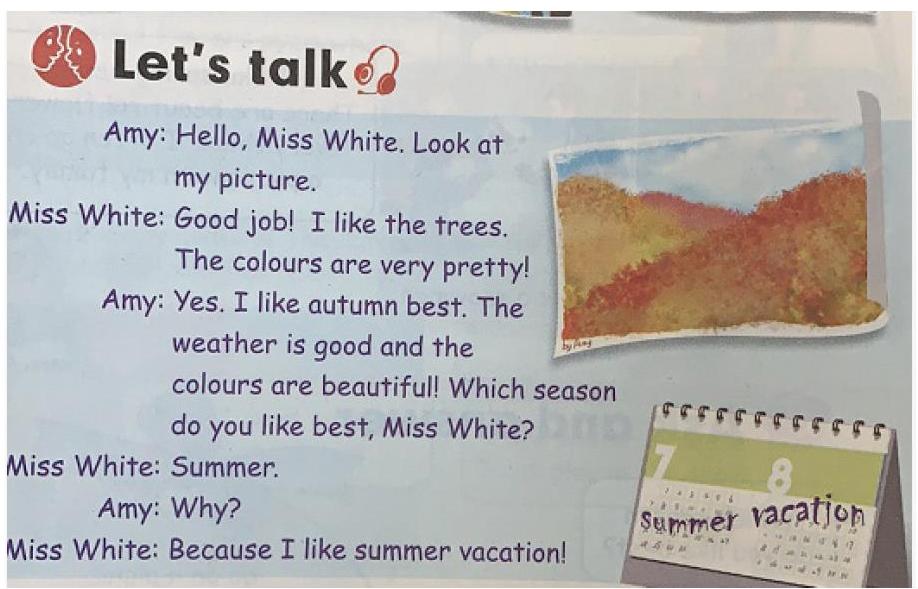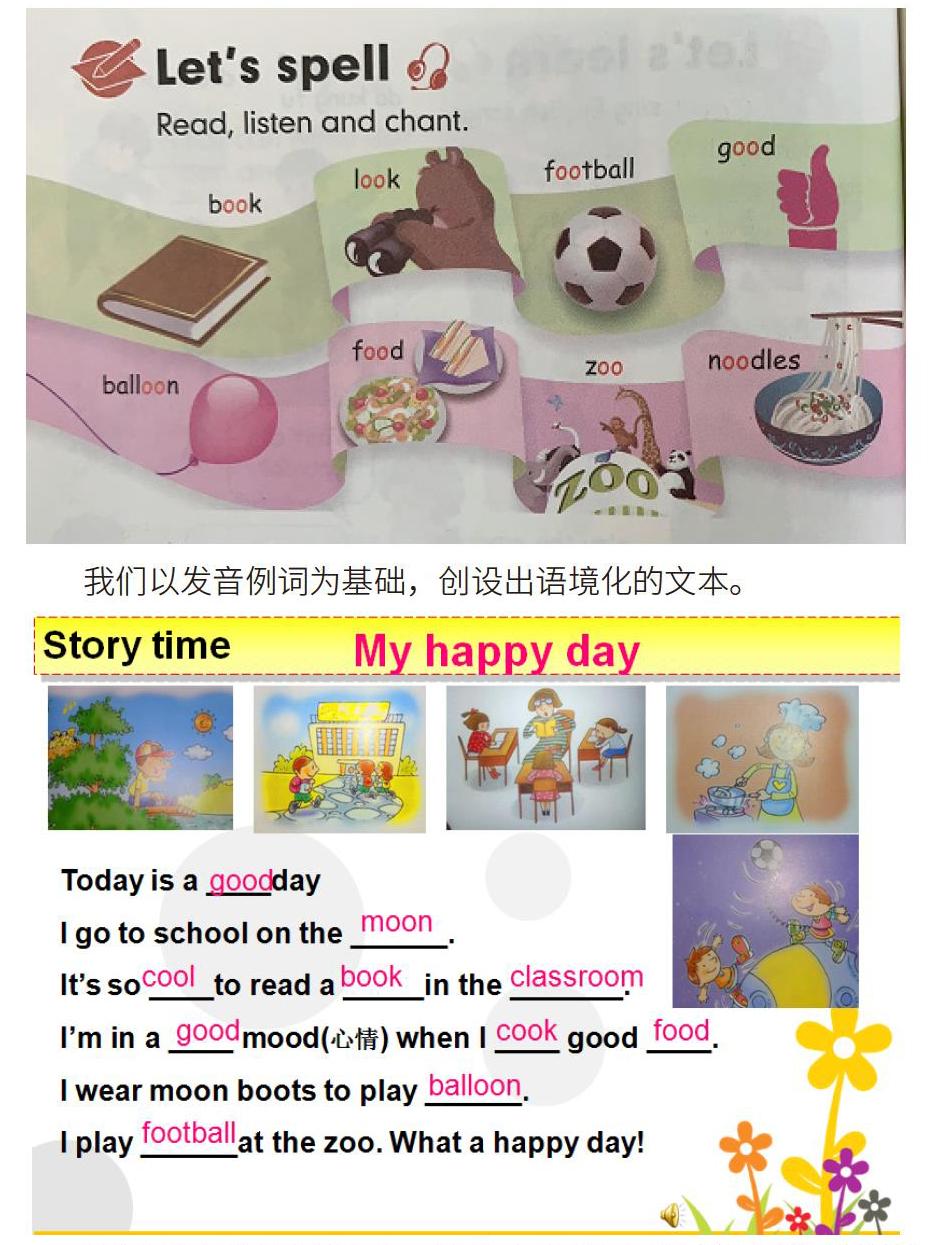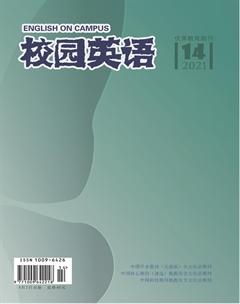再构英语文本,巧妙用活教材



【摘要】《義务教育英语课程标准(2011年版)》中指出:英语课程力求面向全体学生,为学生发展综合语言能力打好基础,同时促进学生整体人文素养的提高。在教学中,教师要善于根据教学的需要,对教材加以适当的取舍和调整。文本再构是教师创造性使用教材的一种路径,有利于激发学生的学习兴趣,培养学生的自主学习能力,从而提高英语课堂教学的有效性。
【关键词】文本再构;原则;方法;内容
【作者简介】韩丽萍, 广东省惠州市李瑞麟小学。
一、文本再构的定义
文本是教学的根本,也是教学的延伸。文本再构是教师对现有教材中的教学内容和学生的实际水平对教材进行二度开发,以教材为语量基础,挖掘语言点,在此基础上进行文本的改编、改写或整合,以适合不同的学生个体或群体。通过教学设计组织学生在新的情景中巩固运用所学语言,提高学生的语言运用能力。
二、文本再构的途径
1.局部再构。局部再构只是在原来教材内容的基础上适当补充或添加部分句子,从而形成新的文本。例如:PEP Book 8 Unit 3 “Where did you go ?” A Let's learn,教材内容只是简单的5个新授词组rode a horse、rode a bike、went camping、hurt my foot 、went fishing,如果只是按传统的拼单词、做单词游戏等,学生学到的就只是一个词或词组。但通过文本局部再构,将单词设计到一个合适的语境中认知和运用,从而构建一个情境性符合学生认知范畴的语言学习材料。
On the Labour Day , I went to Xinjiang with my parents. We rode a horse at Mt. Tianshan. I went camping with my parents. Then we went fishing. We had a good time.
I went to the forest park with my friend on May 2nd. We rode a bike there. It was fun. But I hurt my foot. Next time I should be careful.
2.整体再构。整体再构就是在保留话题主干的基础上,通过分析学情,把握与本话题有关的知识点,特别是新旧知识的联系,将新旧知识进行再构、拓展、重组,文本内容也由易到难、由简到繁,语段的设计层层递进,让学生有一种“跳一跳就能摘到果子”的感觉。例如:PEP Book 6 Unit 2“ My favourite season ”B Read and write,教材内容如下图。
显然,教材文本对五年级学生来说略显简单了。为了把与季节有关的新旧知识联系起来,我们进行了文本再构:
Huizhou is in the south of China. It has four seasons. Spring is the best season of the year. The days get longer, the nights get shorter, and the weather gets warmer. Grass and trees begin to turn green. Children begin to fly kites and go on a picnic outdoors.
Summer comes after spring. It is the hottest season in the year. People try to find a cool place then. They always go swimming in the sea, lakes and rivers. Children like eating ice cream.
Fall is the harvest season. It's gets cool. Farmers begin to gather in food. Many flowers are in full bloom. People are still wearing shirts and skirts.
Winter is short in Huizhou. The weather gets cold but not very cold. It never snows in Huizhou. Children can't play in the snow and can't have the fun of making snowmen or skiing.
再构后的文本融入了三、四年级学过的颜色、食物、天气、穿着等旧知识,本单元关于季节的活动也一脉相承,同时初步接触月份,为接下来有关月份的单元做辅垫。
3.内涵再构。内涵再构指借助教材主题,进一步挖掘主题背后所包含的情感、态度、价值观来进行文本再构。例如:PEP Book 6 Unit 4 “When is Easter ? ”B Read and write,教材表层上描述了两只小猫的生长过程,如果我们在教学中只是简单地把文本学完,那就损失了一个很好的情感升华机会了。但如果挖掘文本背后的情感、态度、价值观,我们就可以再构这样的文本:“当父母慢慢变老了,我们可以为父母做什么?”(如下文)。
During my growth, my parents always do a lot for me. Now my parents are getting older and older. I can show my love to them.I think love can be a kiss or a hug.It can also be a smile or a song.When they are tired,I can give them a cup of tea,I can help them do housework.When I go out ,I will remember give them a telephone call.When I grow up ,I will stay with them and make them happy.
三、文本再构在小学英语教学中的运用
1.运用文本再构,创设词汇教学的整体性。修订后的人教版 PEP教材,每个单元都由ABC三部分组成,其中AB部分都由Let's talk、 Let's learn 组成,在教學设计中,依然存在部分教师只拘泥于教材文本的传统教学方法。文本再构就是要求教师“跳出教材教能力”,通过创设语境促进学生对教学内容更深刻的认知。如果运用文本再构,在文本中带动词汇的学习,学生就能在语境中体验、理解、记忆和运用词汇了。而这种词汇文本再构可以是单元的词汇,也可以是单元与单元之间,甚至是学段与学段之间,目的是新旧内容在不同课时、不同年级中的复现,提炼精华、挖掘知识、充实内容,将教材内容通过纵向与横向联系构成一个较为完整的知识体系,让学生能对所学知识举一反三。例如:PEP Book 8 Unit 2和Unit 3的词汇部分都是关于动词的过去式。我们运用文本再构,把新旧动词融合起来。
May Day
On the first day, I rode a bike to the Honghua Lake. On the way to the lake, I fell off my bike and hurt my foot. I went to the supermarket with my friends and bought some gifts on the 2nd day. On the 3rd day, my brother and I went camping. We took a lot of pictures. In the park, I rode a horse. It was very interesting. On the 4th day, I read some books in the library. In the afternoon, I played badminton with my brother. The 5th day is my favourite day, I was very happy! Because I saw a film with my best friend, We bought many books. We listened to music and watched TV together. The last day, I stayed at home with my parents. I cleaned my room and washed my clothes in the morning. In the afternoon, I went swimming and went fishing. The water was very cold so I got a cold. That was bad! I slept very early.
What a busy holiday!
文本再构体现了教学内容的关联性、递进性以及螺旋上升的知识结构体系,学生在语篇中感受新知的同时复习旧知,提高了综合语言运用能力。
2.运用文本再构,充实对话的交际性。教材中对话部分是把单元中的核心词汇和句子融入有意义的语境中,帮助学生巩固记忆并形成语言运用能力。但如果教学中只是停留在某个对话内容上孤立地使用,话题与话题之间毫无关系,那么学生也只是“只见树林未见森林”。例如:PEP Book 6 Unit 2 “My favourite season ”B Let's talk的内容如下图:
Amy: Hello, Miss White. Look at my picture. I like fall best.
Miss White: Why ?
Amy: Because the weather is good and the colours are beautiful. Many flowers and trees are in full bloom.I can pick apples.I can go on apicnic.And my birthday is in fall. How wonderful!What about you ?
Miss White: I like season.
Amy: Why?
Miss White: I like spring, because it's warm. The birds are singing. The butterflies are dancing. They're happy. I'm happy too. I can go hiking. I can catch butterflies, pick up leaves,take pictures. But I also like summer, beacause I like summer vacation !
Amy : Haha...Cool!
教师对文本进行再构,充实对话的内容,相关的旧知和新知围绕一个话题,拓展了对话的交际性。
3.运用文本再构,增加语音教学的语用性。修订后的人教版PEP教材非常注重语音教学,增加了Letters and sound和Let's spell板块,但由于教材没有安排对音标的学习,学习学生难度很大。在教学中我们除了利用Phonics来进行教学外,如果以发音例词为基础创设出语境化的文本,这将大大降低学习难度,让学生在文本中自然感知词汇中所含字母的发音。例如:PEP Book 5 Unit 4 “What can you do? ”A Let's spell(如下图)。
我们以发音例词为基础,创设出语境化的文本。
通过绘本故事的形式,学生在语境中感知詞汇的发音规律,达到事半功倍的效果。
4.运用文本再构,拓展读写教学的延续性。教材中的Read and write板块是学生融合新旧知识、内化知识体系的过程,也是学生对单元主题语言内化输出的过程,是语言发展的高阶。教师应该根据单元的核心词汇与句子,对文本进行再构,促进学生语言能力的综合发展。例如:PEP Book 6 Unit 3 “What would you like ? ”B Read and write(如下图)。我们学习原文本后,通过内涵再构的方式拓展了新的文本。
Eating right is very important. It can help you stay healthy.Every day you must eat a lot of grains, like rice, noodles, wheat.And you must eat a lot of vegetables and fruits. You also need to eat some protein. There is protein in milk, fish, eggs and so on. It helps you grow. But you don't eat much food with rich sugar and calorie. It is unhealthy.
四、结语
教师要想在英语教学中发挥出文本再构最大的功效,就要做到心中有教材、眼中有学生。只有以教材的主题为语用基础,在学生的现有知识储备量及最近发展区之间搭建起语言支架,以学生的需求及教材的空白点、冲突点作为创造语境的依据,才能调动学生的语用情趣,体现语言运用的有效性。文本再构在英语教学中的运用还处于初步尝试阶段,在再构的过程中,如何拓展、拓展哪些内容、拓展到何种程度、语言输入量如何得到保障、再构出来的文本是否符合学生的认知水平等问题都是我们今后要花很长时间探讨和实践的问题。
参考文献:
[1]教育部.义务教育英语课程标准(2011年版)[M].北京:北京师范大学出版社,2012.
[2]徐静,郭淑华.基于语篇意识的文本再构[J].小学教学设计,2015 (36):12-13.

